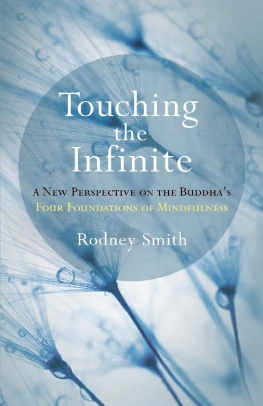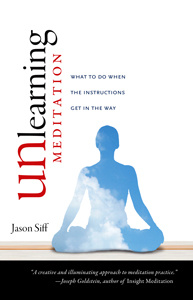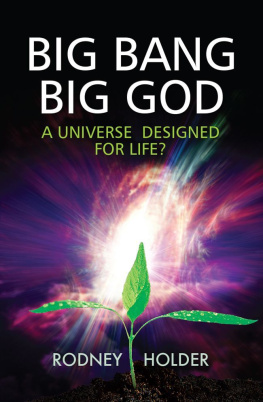Rodney Smith - Touching the Infinite
Here you can read online Rodney Smith - Touching the Infinite full text of the book (entire story) in english for free. Download pdf and epub, get meaning, cover and reviews about this ebook. year: 2017, publisher: Shambhala, genre: Religion. Description of the work, (preface) as well as reviews are available. Best literature library LitArk.com created for fans of good reading and offers a wide selection of genres:
Romance novel
Science fiction
Adventure
Detective
Science
History
Home and family
Prose
Art
Politics
Computer
Non-fiction
Religion
Business
Children
Humor
Choose a favorite category and find really read worthwhile books. Enjoy immersion in the world of imagination, feel the emotions of the characters or learn something new for yourself, make an fascinating discovery.

- Book:Touching the Infinite
- Author:
- Publisher:Shambhala
- Genre:
- Year:2017
- Rating:3 / 5
- Favourites:Add to favourites
- Your mark:
- 60
- 1
- 2
- 3
- 4
- 5
Touching the Infinite: summary, description and annotation
We offer to read an annotation, description, summary or preface (depends on what the author of the book "Touching the Infinite" wrote himself). If you haven't found the necessary information about the book — write in the comments, we will try to find it.
Touching the Infinite — read online for free the complete book (whole text) full work
Below is the text of the book, divided by pages. System saving the place of the last page read, allows you to conveniently read the book "Touching the Infinite" online for free, without having to search again every time where you left off. Put a bookmark, and you can go to the page where you finished reading at any time.
Font size:
Interval:
Bookmark:
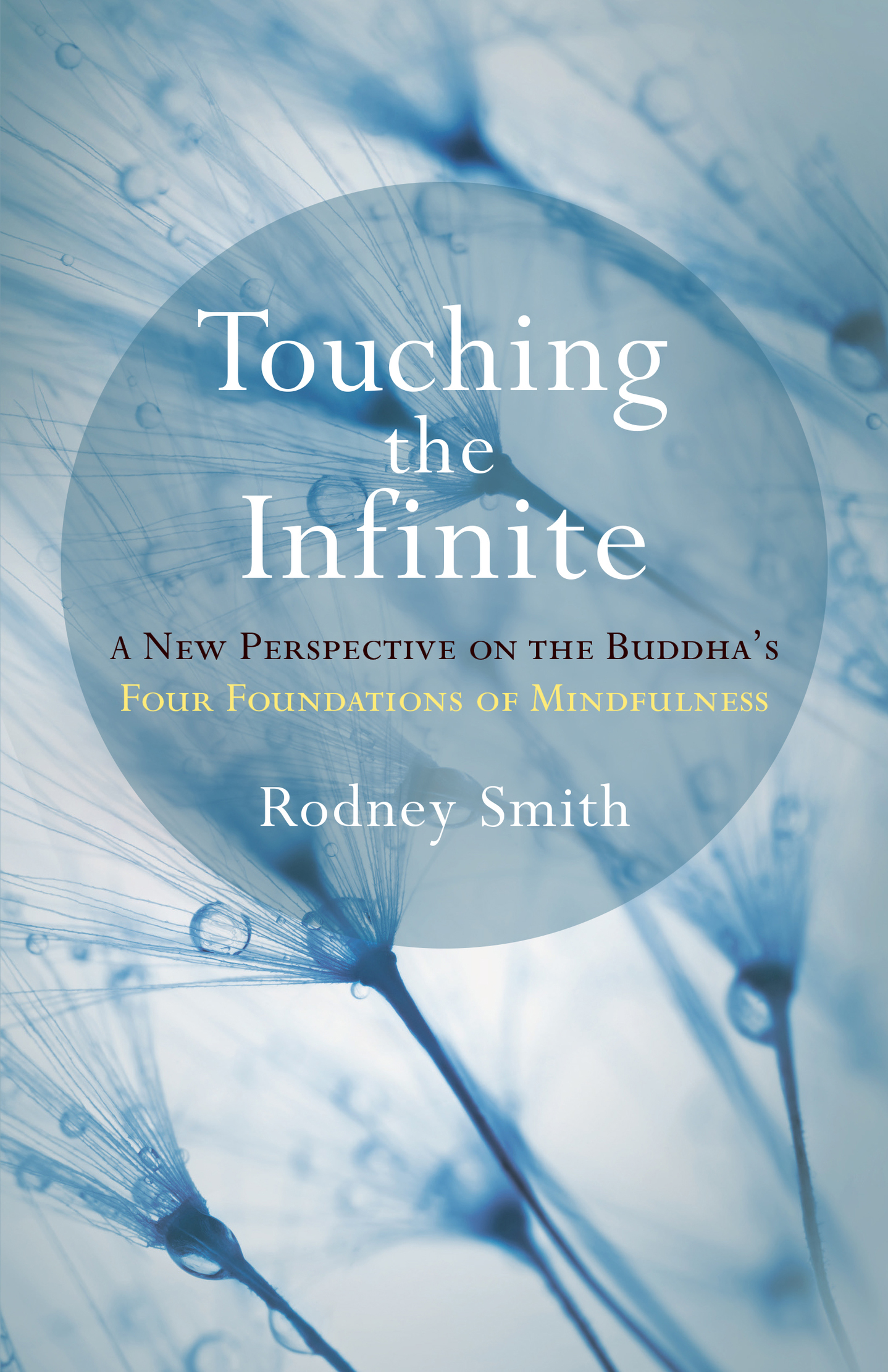
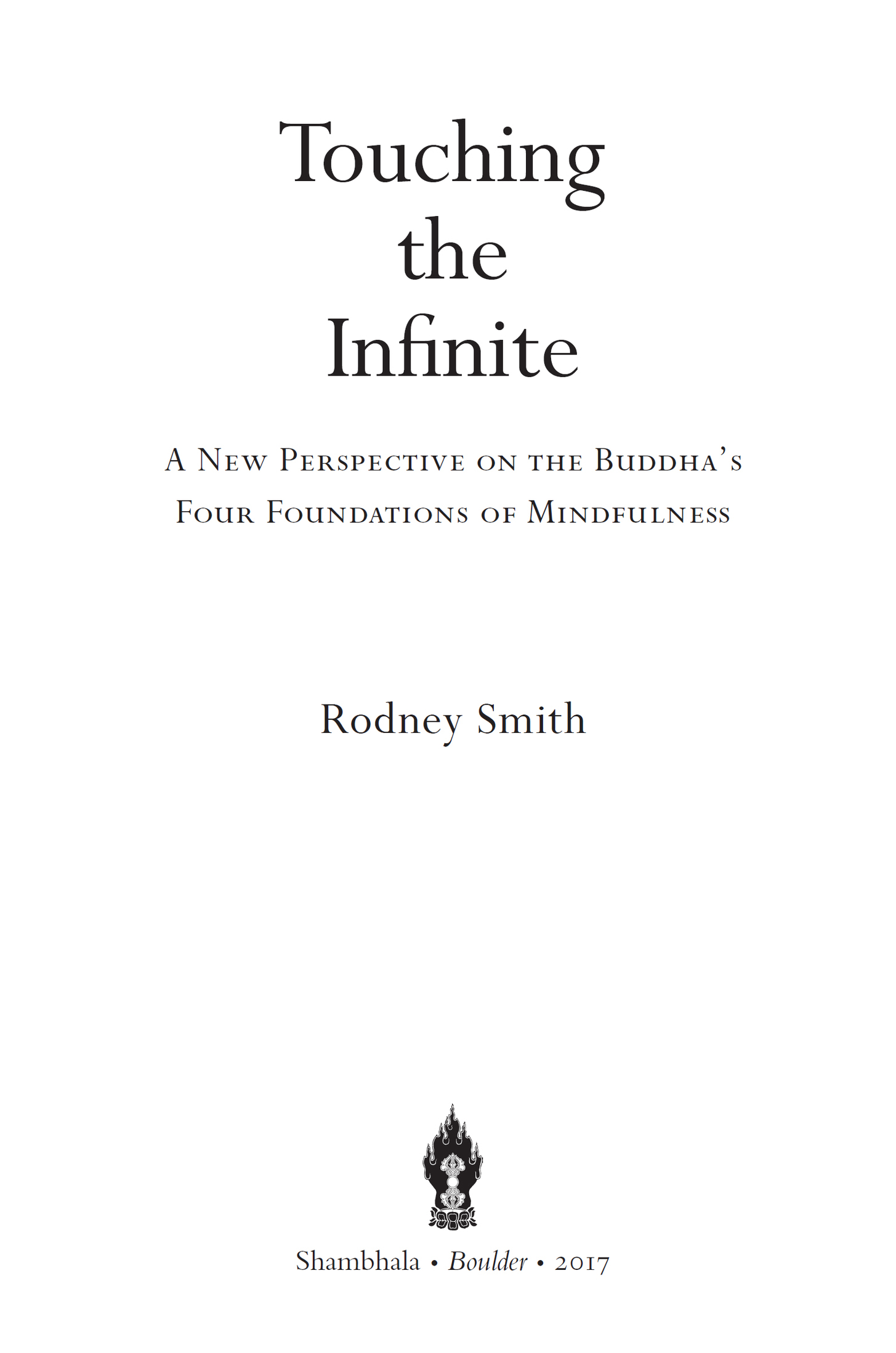
Rodney Smith shares the beautiful fruits of his many decades of devoted practice of the Buddhas teachings. Touching the Infinite freshly unpacks the instructions on touching the true nature of reality through developing an intimate relationship with the living components of our own direct, moment-to-moment experience. Seekers of system updates for dharma in the twenty-first century will find much fulfillment in this book, which has been written from the heart in a voice that is delightfully creative.
Dzogchen Ponlop, author of Penetrating Wisdom and Rebel Buddha
I highly recommend Rodney Smiths book Touching the Infinite. His explanations are interesting, lucid, and practical. The Four Foundations of Mindfulness are, in themselves, a most important guide to the realization of the dharma. I congratulate Rodney on his excellent work.
Ajahn Sumedho, author of The Sound of Silence and The Way It Is
Books by Rodney Smith
Awakening: A Paradigm Shift of the Heart
Stepping Out of Self-Deception: The Buddhas Liberating
Teaching of No-Self
Shambhala Publications, Inc.
4720 Walnut Street
Boulder, Colorado 80301
www.shambhala.com
2017 by Rodney Smith
All rights reserved. No part of this book may be reproduced in any form or by any means, electronic or mechanical, including photocopying, recording, or by any information storage and retrieval system, without permission in writing from the publisher.
Cover art: Master le Royalty Free
Cover design by Jim Zaccaria
L IBRARY OF C ONGRESS C ATALOGING - IN -P UBLICATION D ATA
Names: Smith, Rodney, 1947 author.
Title: Touching the infinite: a new perspective on the Buddhas four foundations of mindfulness / Rodney Smith.
Description: First edition. | Boulder, Colorado: Shambhala Publications, Inc., [2017] | Includes bibliographical references.
Identifiers: LCCN 2017002652 | ISBN 9781611805024 (pbk.: alk. paper)
eISBN 9780834841185
Subjects: LCSH: Satipatthna (Buddhism)
Classification: LCC BQ5630.S2 S58 2017 | DDC 294.3/4435dc23
LC record available at https://lccn.loc.gov/2017002652
v4.1
a
What we are doing is observing the very act of creation.
A JAHN C HAH
To my wife, Ellen, whose loyalty and support sustain me, and to Parker Huey who always gets it right.
This book is not a scholarly endeavor, as I do not have the background or temperament for that kind of precision. The book does, however, come from over forty years of immersing myself in the practice and realization of Buddhism. Having lived for that length of time within the framework of Buddhist thought, I am sensitive when something seems to be in or out of alignment with the overall body of the Buddhas teaching.
For years I have tried to navigate the antiquated language, the scholarly interpretations, and the commentarial confusion of the Buddhas Four Foundations of Mindfulness. Despite the fact that the Satipatthana Sutta has been shrouded in twenty-five hundred years of opinions, somehow I knew there must be a linear and cohesive way into this sutta that was both obvious and simple. I knew that each foundation could not stand alone but ultimately must be tied to the other three foundations within a unified and organized direction. A question I often ponder when studying any sutta, including this one, is where is the Buddha pointing in context to his overall teachings, and how does this sutta move us seamlessly and cohesively toward that end?
This book offers a different perspective on the Satipatthana Sutta, one that makes intuitive and reasoned meaning given the Buddhas overall message. My sense is that Buddhism in the twenty-first century is becoming a bit too staid and predictable. There seems to be too much reliance on what others have said about the teachings rather than an immersion and self-exploration of those teachings. It is as if over the centuries a decisive scholarly map has been drawn onto the face of Buddhism, and we are encouraged to follow that map despite our individual needs or perspectives. Such a strict conclusive interpretation is counter to the Buddhas message of investigation and realization that lies at that heart of his training. Furthermore, only in the broadest sense can any map correspond to an individuals experience or spiritual unfolding. The path of awakening is just too disparate to be predictable.
I do not believe that the Buddha would have wanted us to become ideologically fixed within his teaching. I experience his teaching as wide open and contemporary, encouraging us toward our own realization within his absolute mandate to never accept anything based upon what others have said until it has been radically investigated and ingested by each one of us. His was a call toward individual exploration by testing his conclusions according to our own experience.
Once I deciphered to my satisfaction the cohesive message that lies within this discourse, I saw that the Four Foundations systematically move us from form to the formless. This is not contradictory to many interpretations of the suttaexcept for the Fourth Foundation. I believe the Fourth Foundation drops us off in the timeless and formless expression of reality. The Buddha frames this foundation by what we see (Four Noble Truths, the Five Aggregates, Seven Factors of Enlightenment, and so on), and thus many interpretations have focused on the contemplation of these mental qualities as the basis for the practice. But the Buddha seems to be pointing directly to the formless, which can only be characterized by what is held within it since awareness itself has no formed qualities that can be perceived. From my perspective, the Fourth Foundation is concerned with the seeing (formless awareness) and not with what is seen (mind objects). This explanation ties together the progression of instructions of the first three foundations, which move us from the solidity of body to the more subtle aspects of form, including feelings and mind, before ultimately opening us to the formless that is not an object.
In the Fourth Foundation the Buddha is suggesting that it is not what we see, but how we look that is the essential point in discovering the formless. If we look at the content through desire or fear we will see the minds projected interpretation of the world, but if we allow our perceptions to be transformed by the Buddhas teaching (Four Noble Truths, Five Aggregates, and so on) then we look through wisdom, and the objects will return to their essential nature. In effect, the Buddha is saying that if we are seeing through our mental constructs we will see only what the mind allows us to see, but if we use the teaching to change the way we perceive, we will see the objects intrinsic emptiness. Instead of simply contemplating these mental qualities, he is advising us to use the wisdom these teaching provide to directly access the formless.
A C ASE FOR I MPLIED D HARMA
After twenty-five hundred years, including five hundred years of oral transmission, the suttas have been distilled down to their bare essentials in order to facilitate their communication and delivery. Likely much is missing from the actual teaching delivered so long ago, and perhaps more importantly, much has been embellished and distorted along the way. I feel we can rejuvenate the suttas and infuse them with renewed life through our own insights and modern metaphors.
Font size:
Interval:
Bookmark:
Similar books «Touching the Infinite»
Look at similar books to Touching the Infinite. We have selected literature similar in name and meaning in the hope of providing readers with more options to find new, interesting, not yet read works.
Discussion, reviews of the book Touching the Infinite and just readers' own opinions. Leave your comments, write what you think about the work, its meaning or the main characters. Specify what exactly you liked and what you didn't like, and why you think so.

